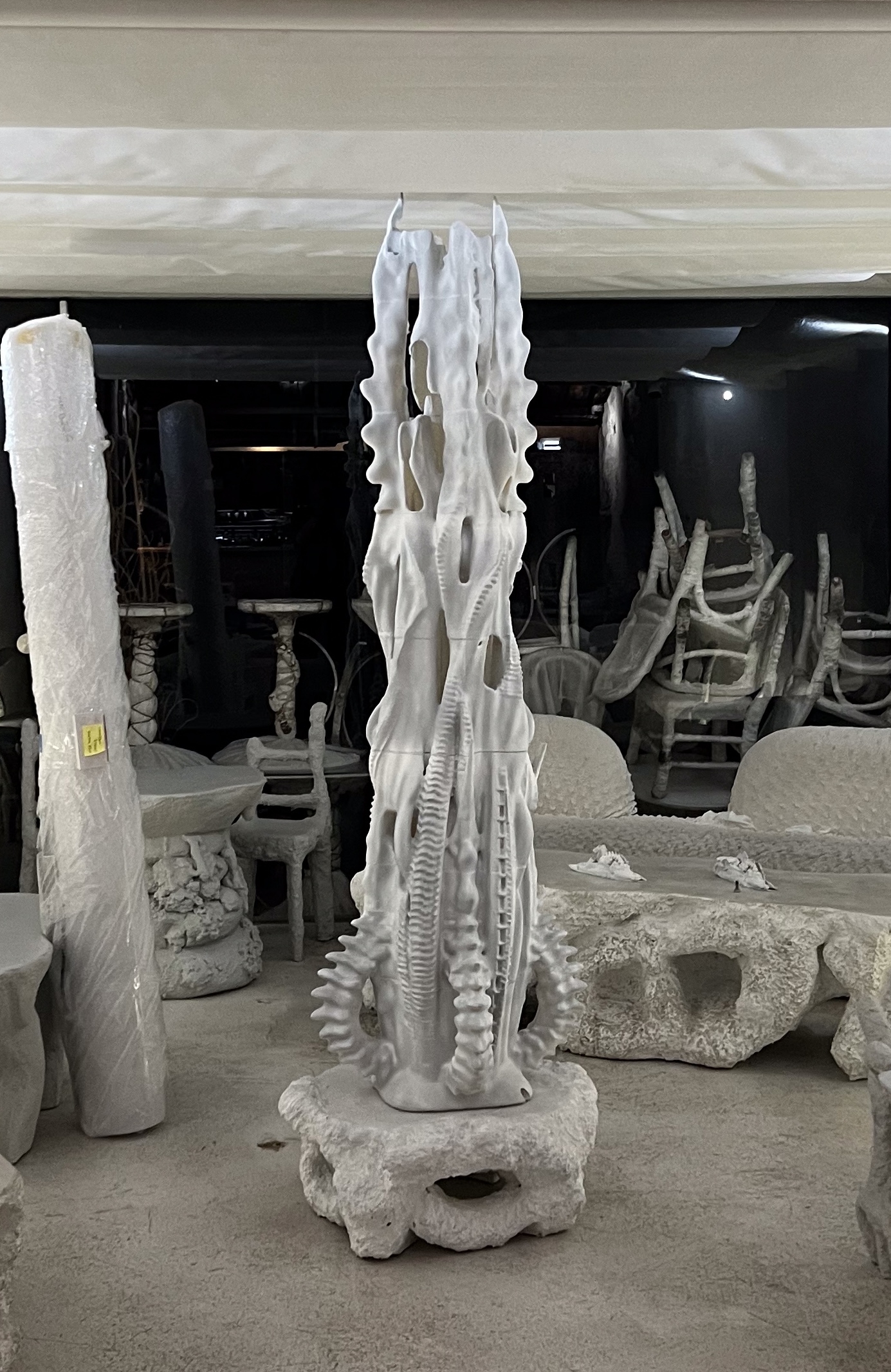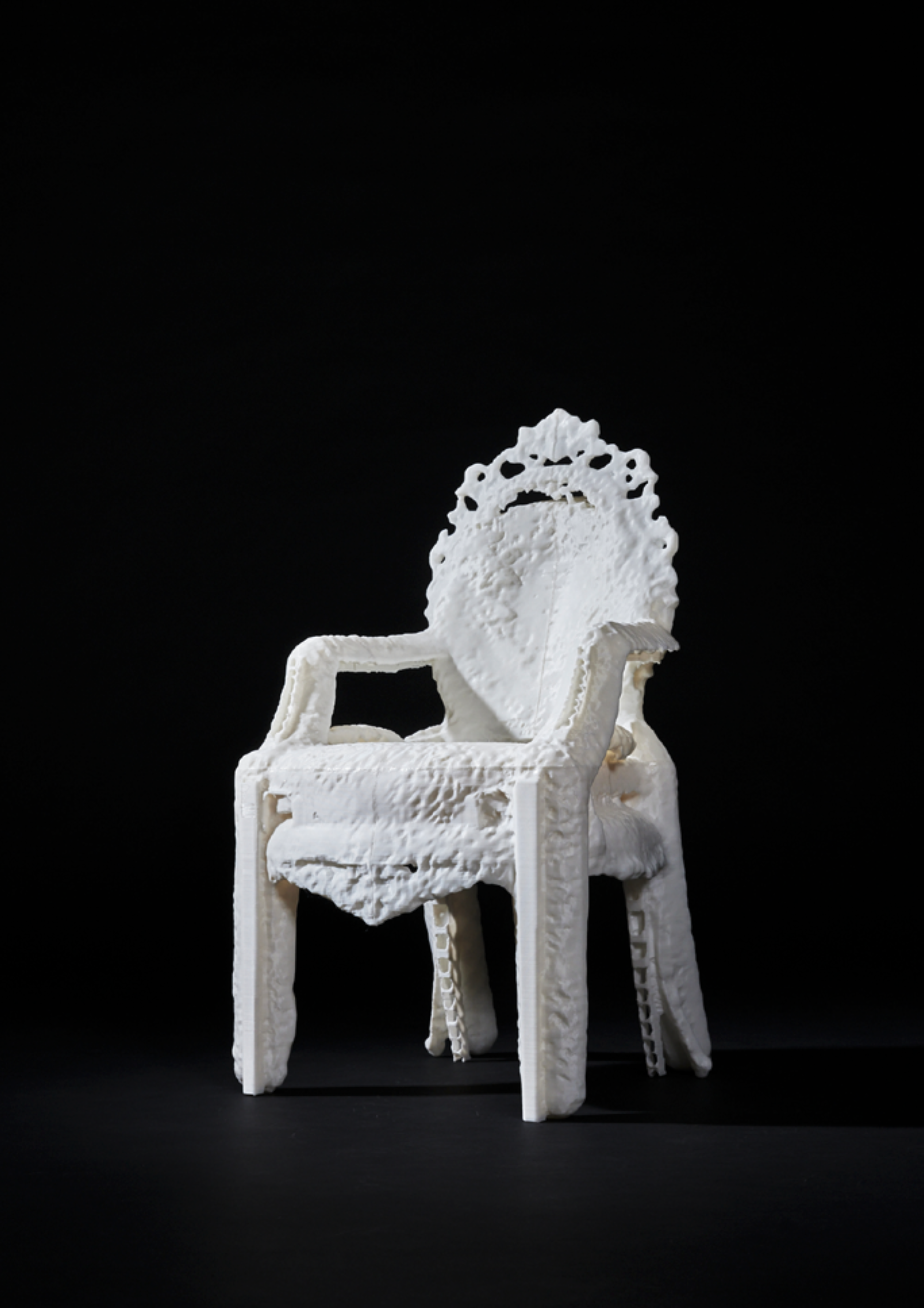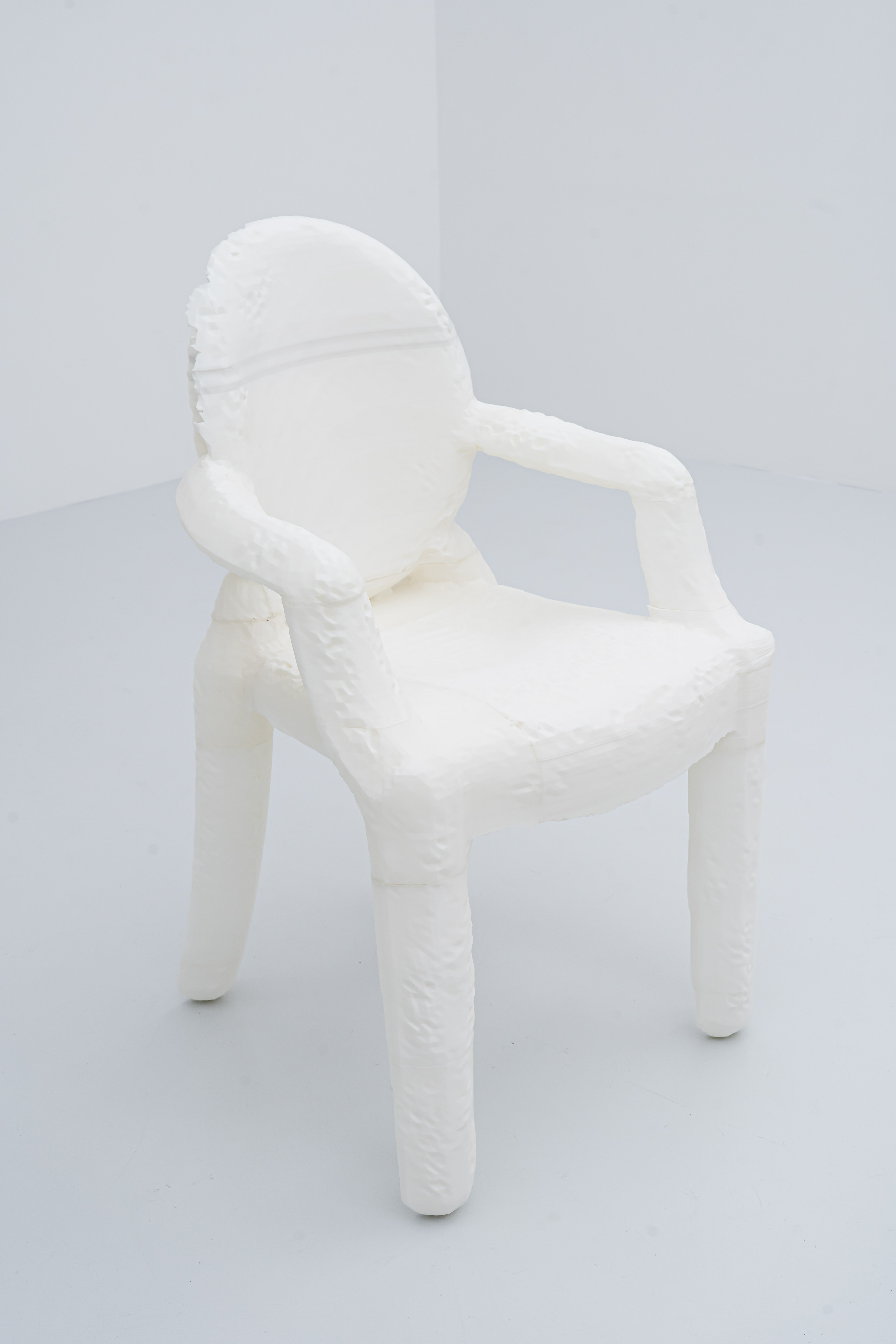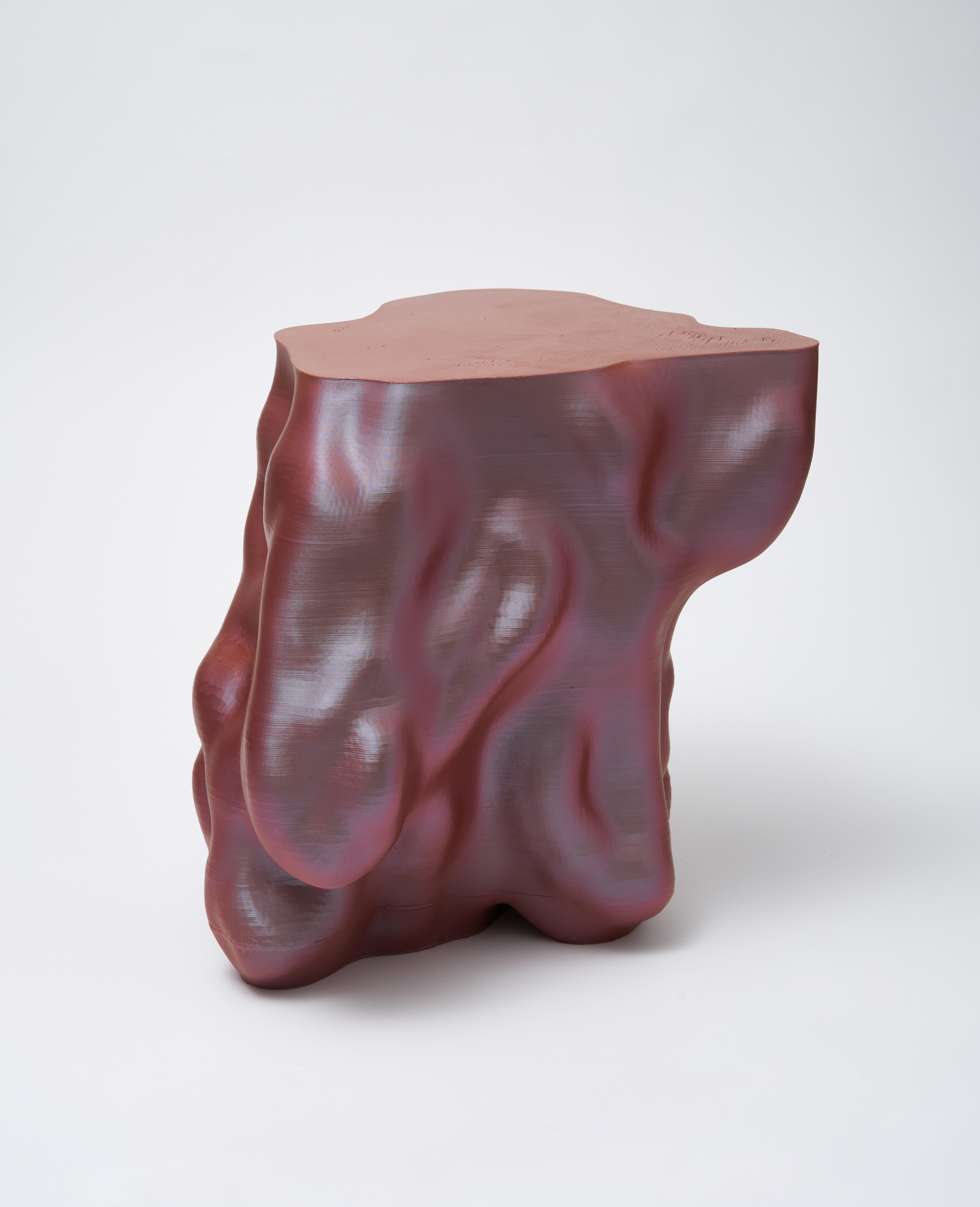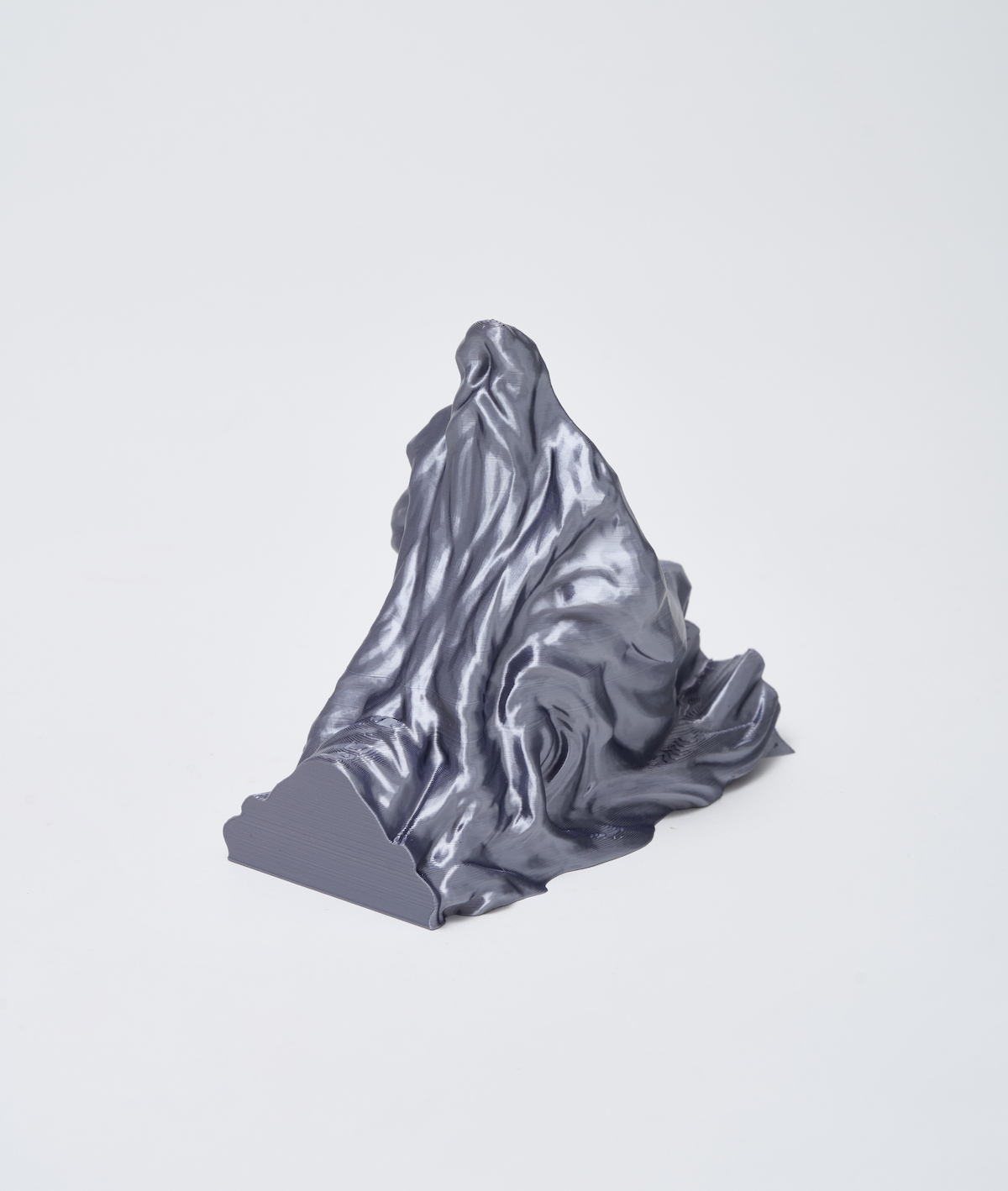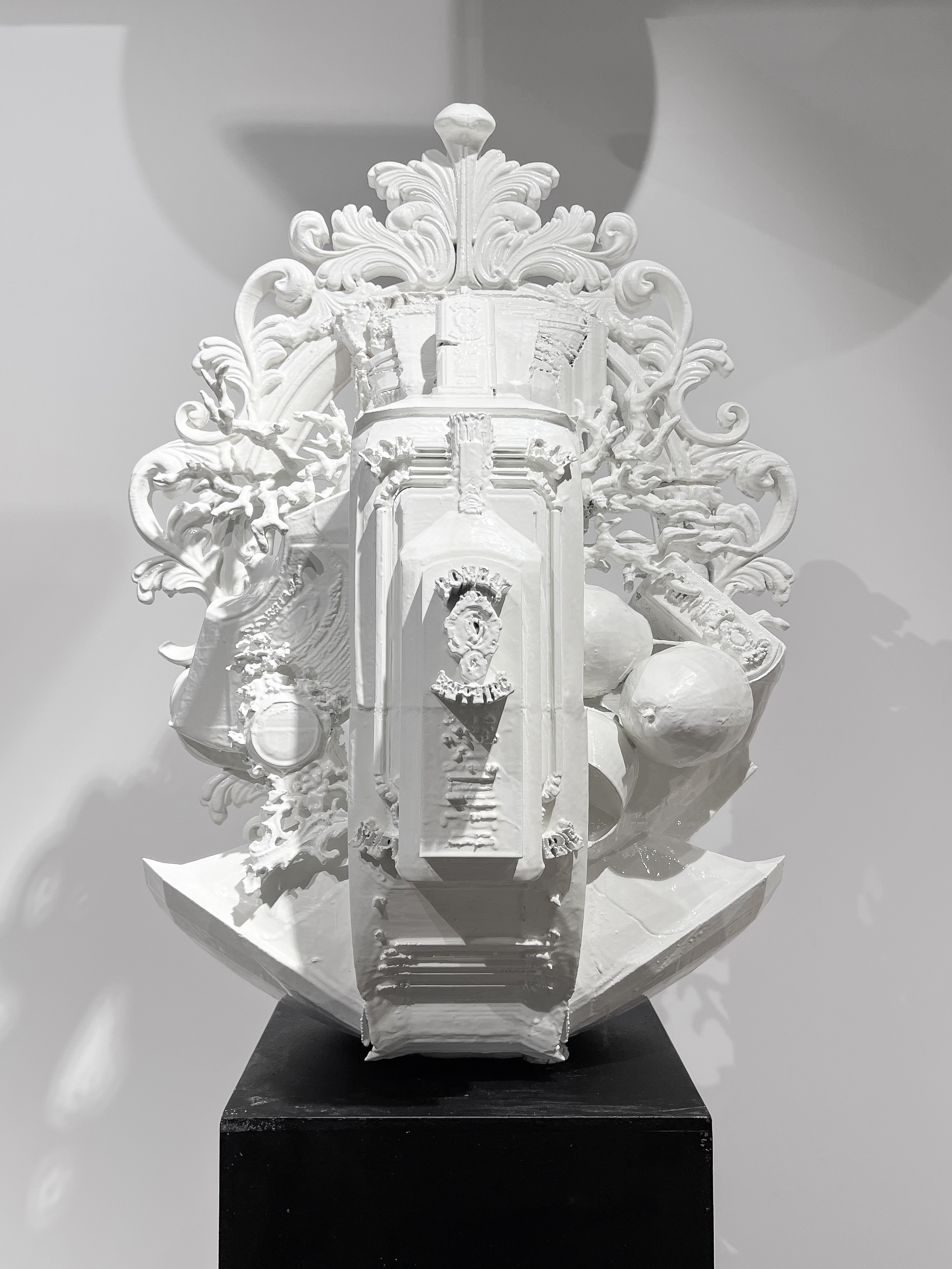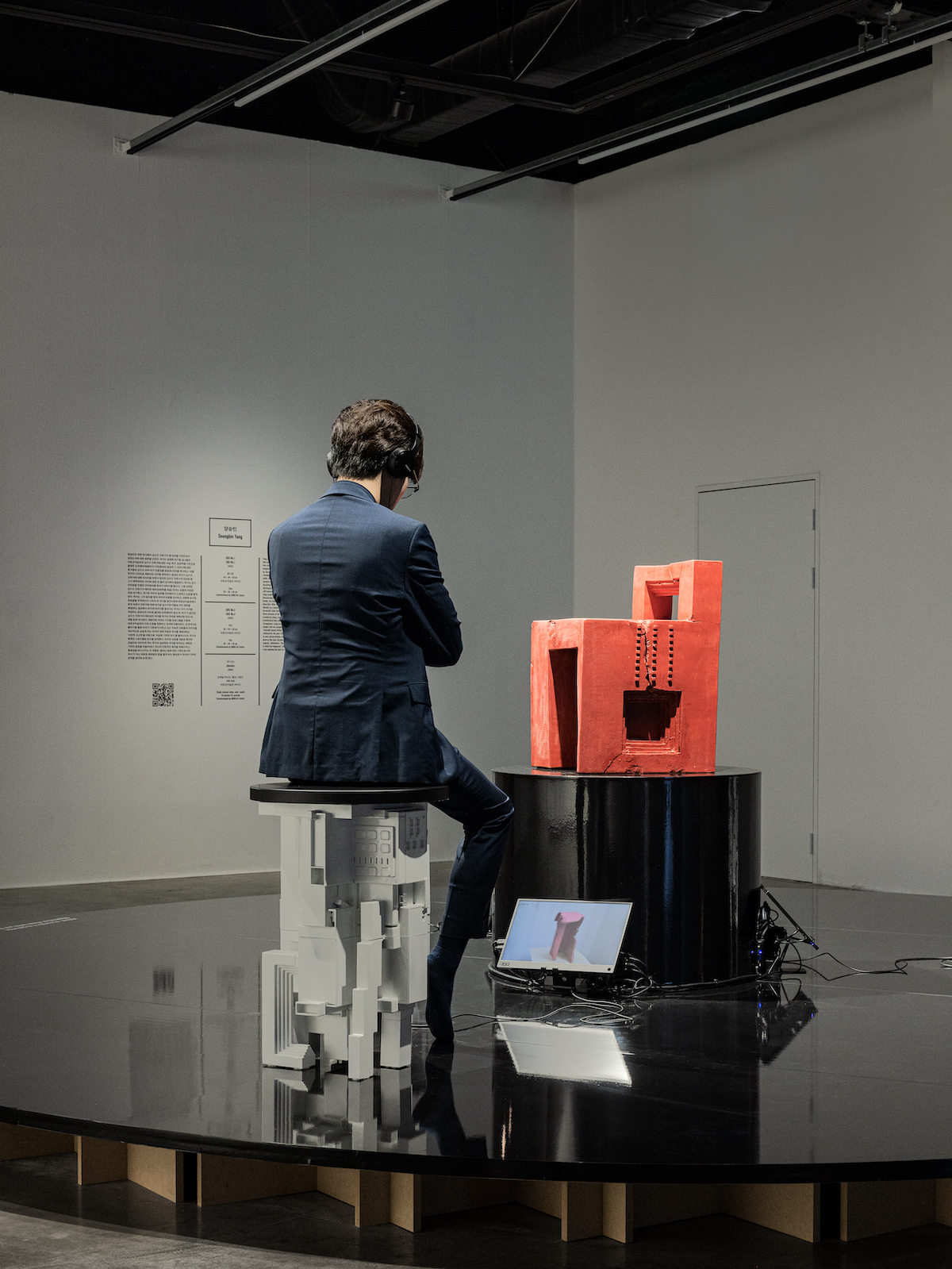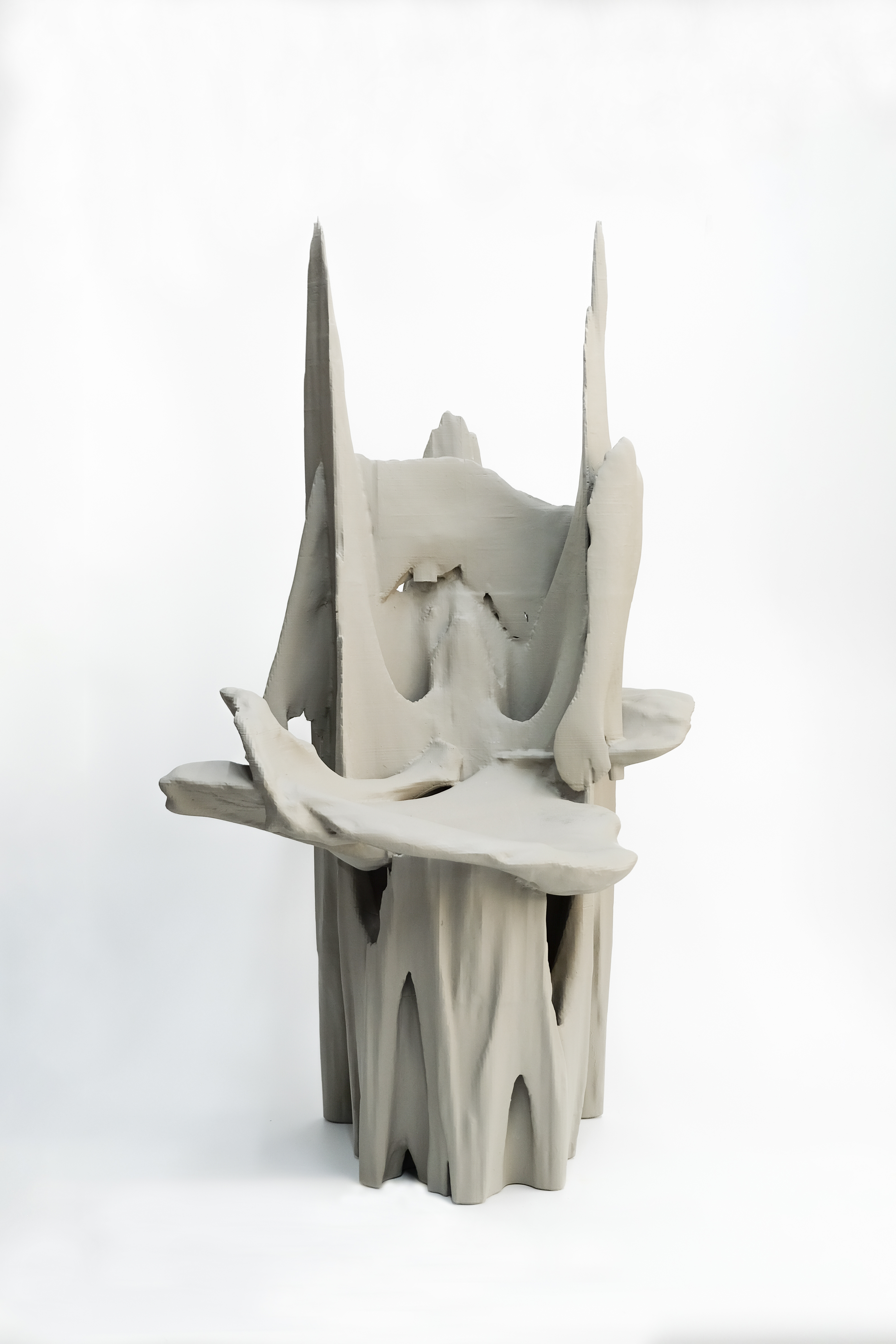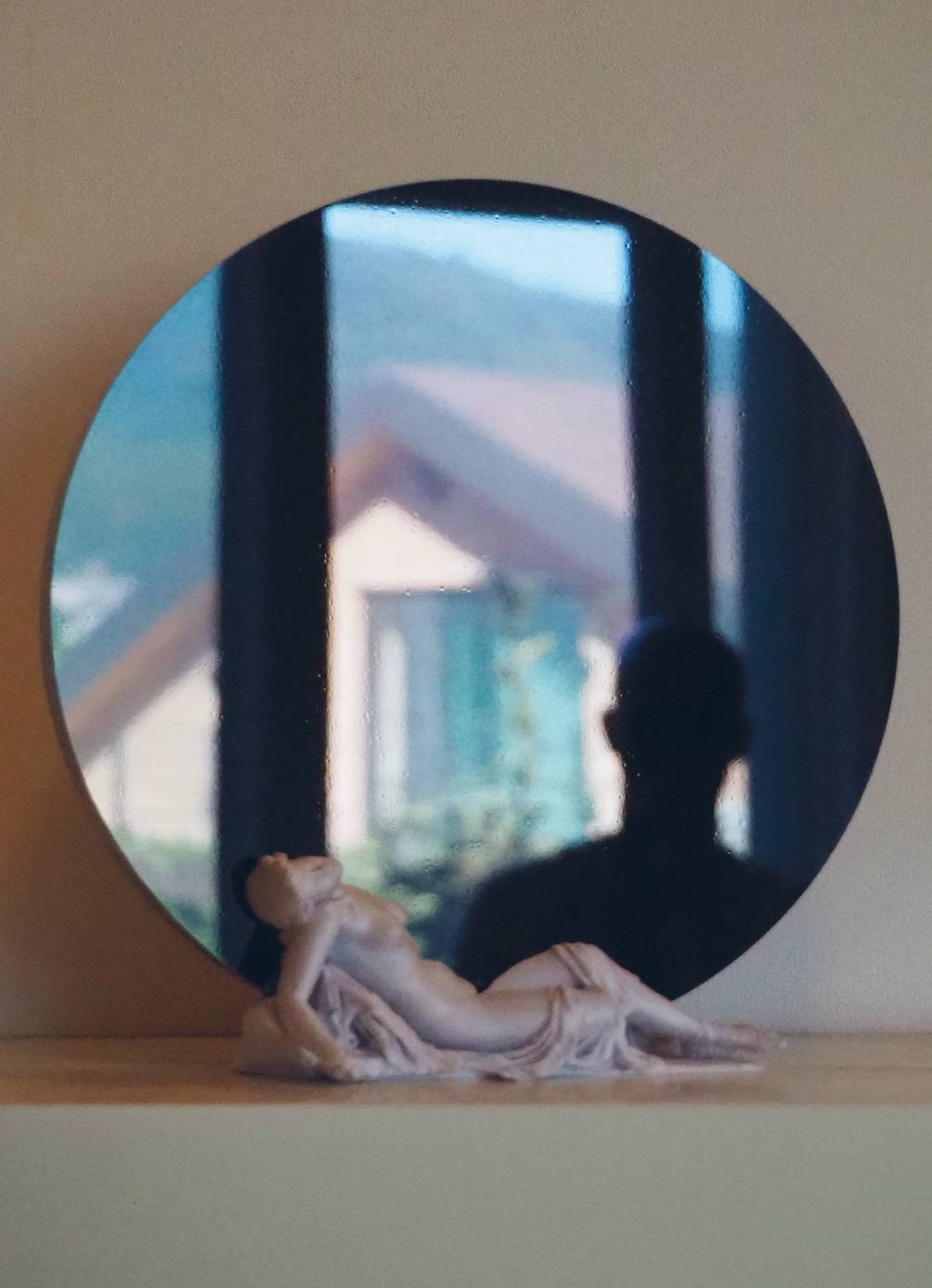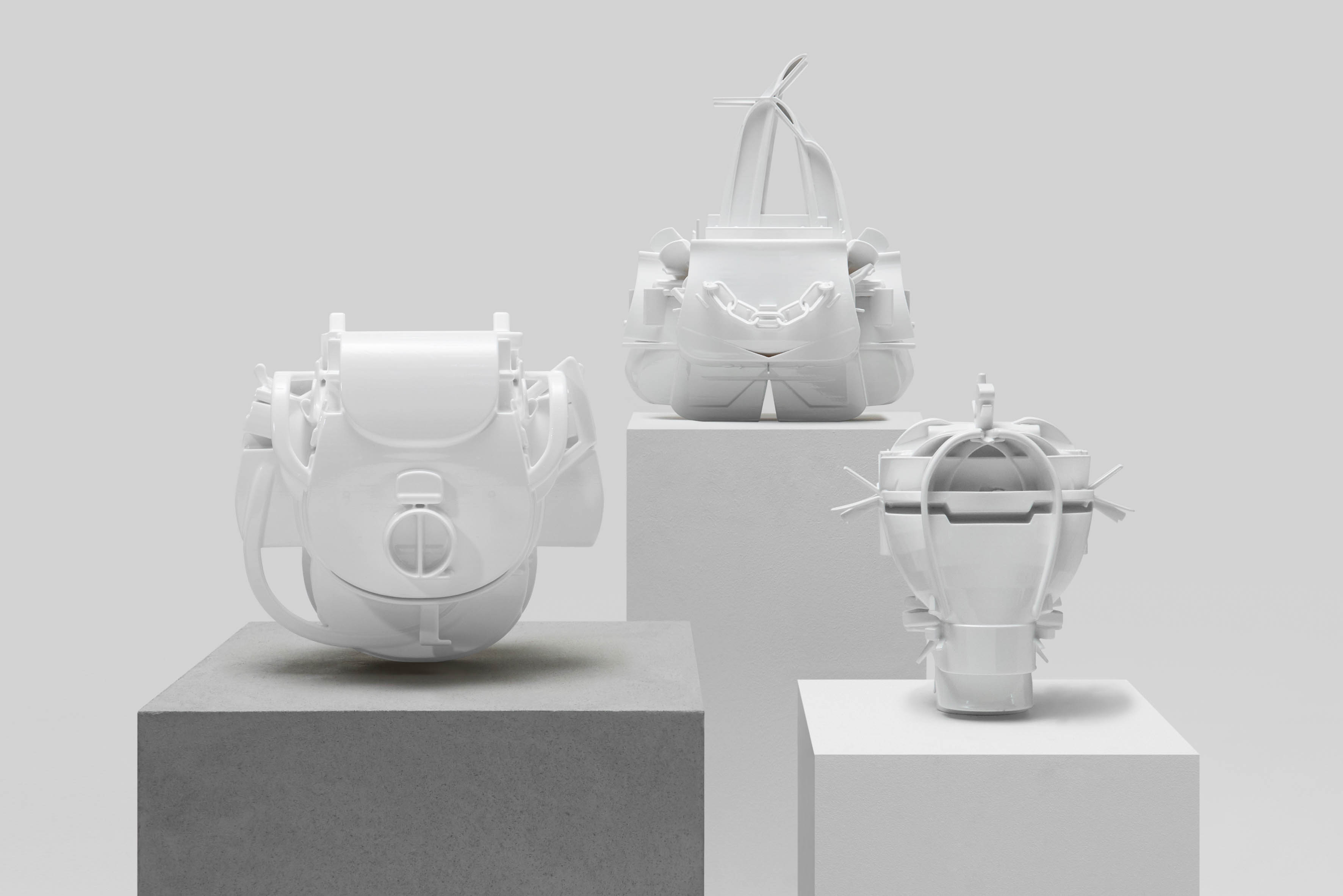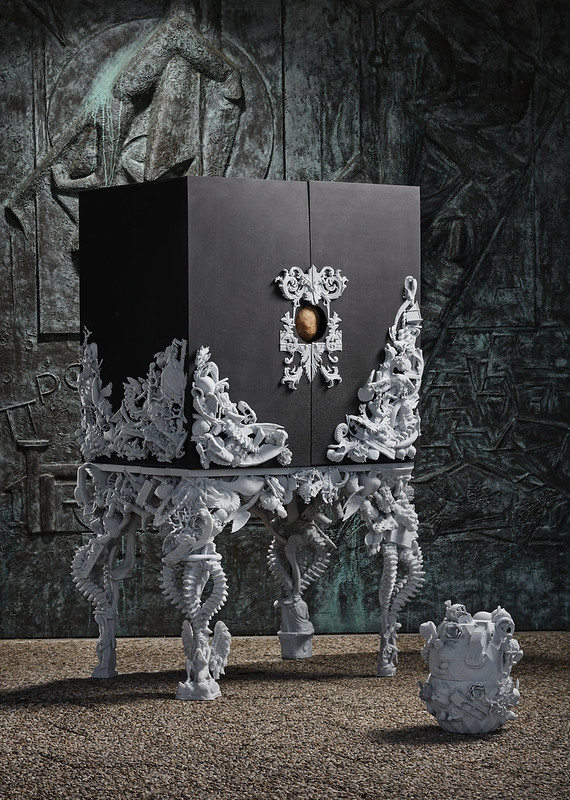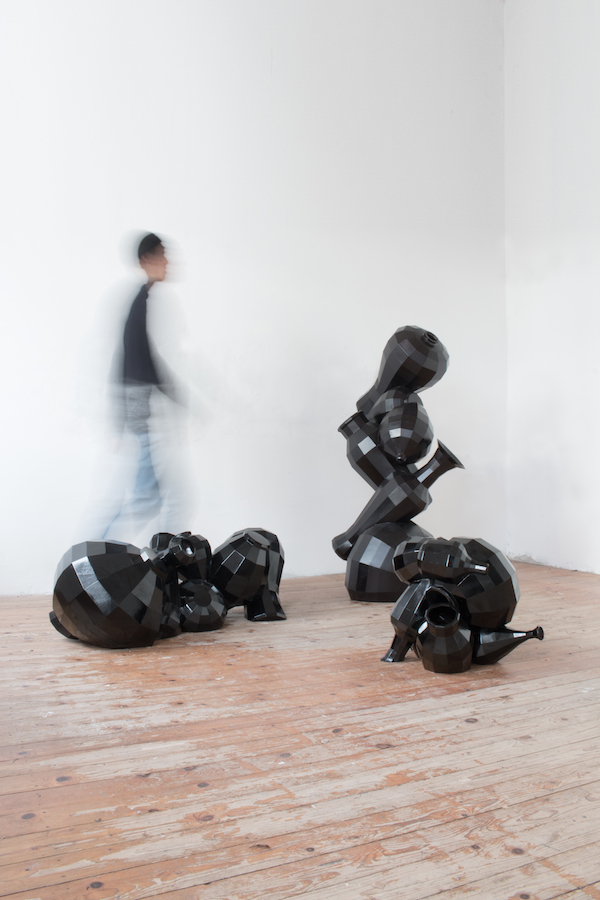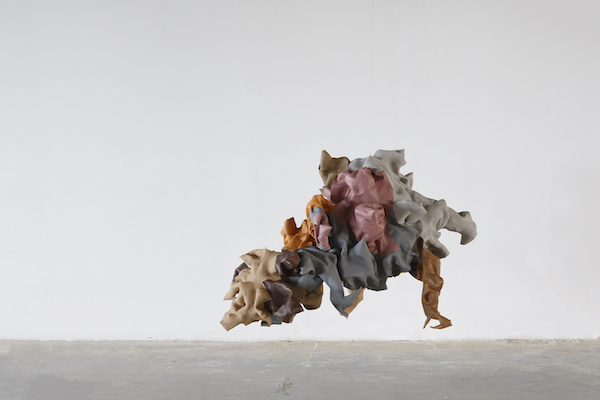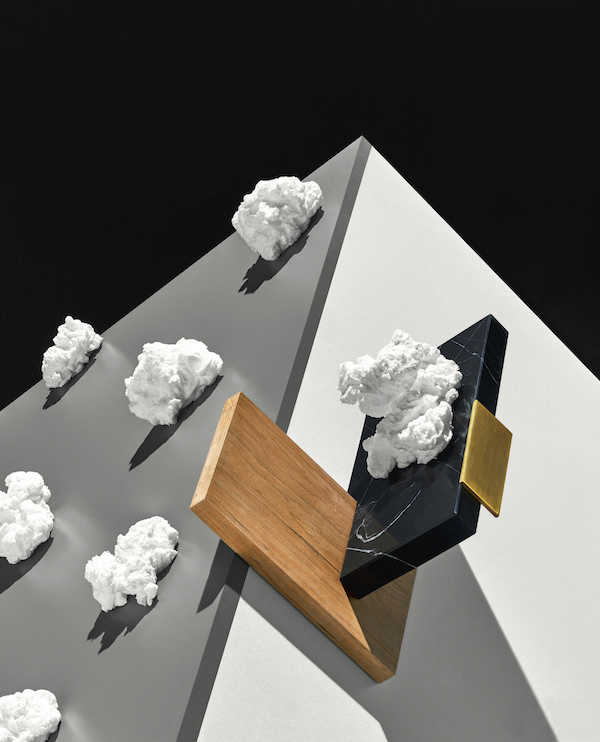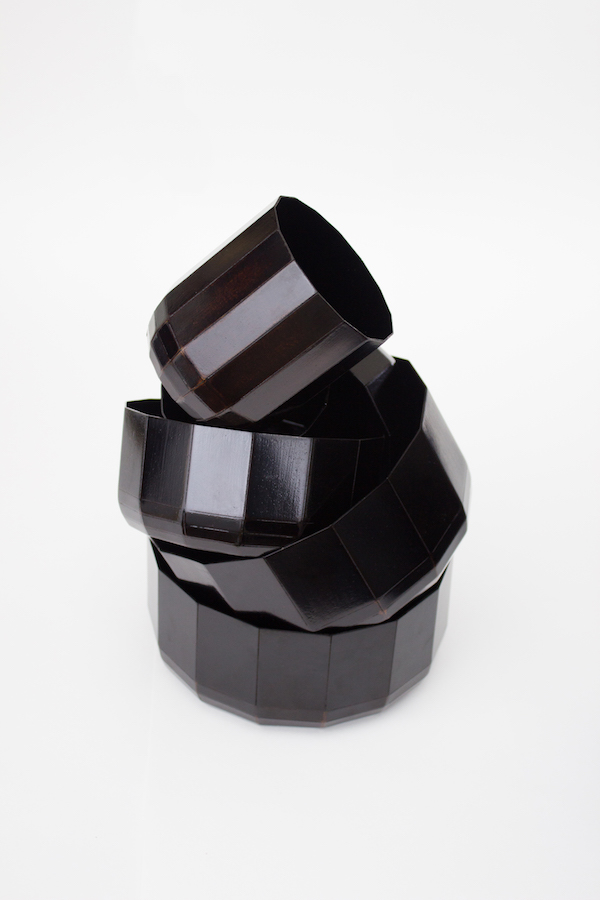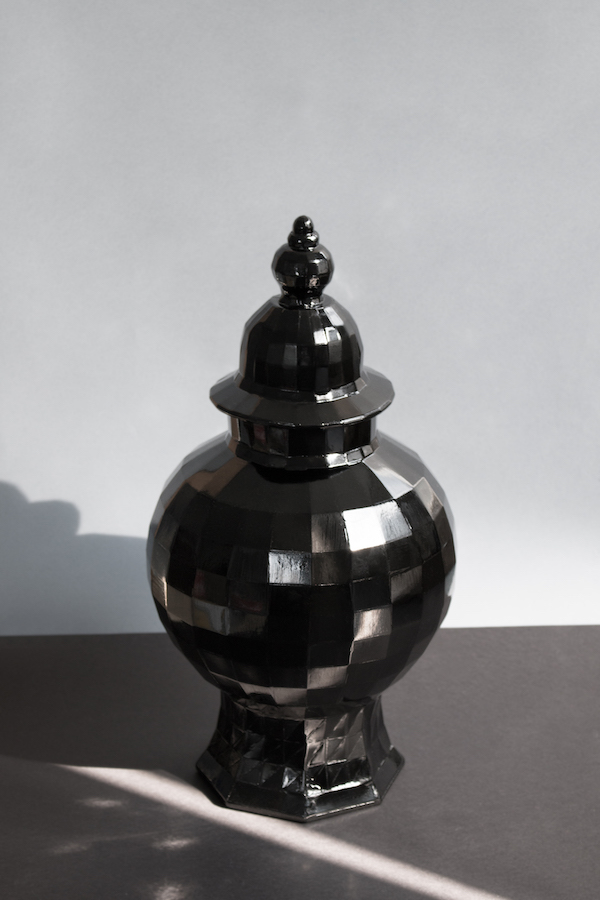

Jamais vu (미시감)
Acrylic, PLA (Polylactic Acid)
2022
200 (W) X 14 (L) X 204 (H)
The history of the mirror begins with the history of human civilization itself. The earliest mirrors were made of obsidian. In ancient tombs in Anatolia, now part of modern-day Türkiye, archaeologists discovered polished, circular obsidian mirrors dating back to around 6000 BCE. This suggests that mirrors were not merely practical tools, but also important mediators for self-awareness and, further, for exploring humanity’s relationship with the world. Unlike today, when mirrors are readily available and part of everyday life, they were once rare, ritualistic, and symbolic objects—among the first devices through which humans confronted their own image and reflected on their existence.
Today, the mirror is an object so familiar to us that it is almost invisible. Each morning we stand before it to examine ourselves—checking our appearance, complexion, expression. Yet this act goes beyond simple grooming. Looking into a mirror is the first step in recognizing the self in the present moment, the beginning of the question: Who am I? As a tool of self-awareness, the mirror generates a constant exchange between subject and object. In seeing and being seen simultaneously, the self becomes caught in a reversible relationship where perception and reflection intersect. This exchange exceeds mere visual reflection; it operates as a medium through which the self and the world cross and communicate.
The essence of the mirror, therefore, is not only the act of seeing oneself, but also of internalizing the gaze of the other. To see one’s own face in the mirror is at the same time to anticipate how it might appear to another. The question “How do I look?” reveals that the gaze within the mirror is not directed solely inward but is always shaped in relation to others. In this way, the gaze of the mirror begins with the self but ultimately converges with the gaze of the other, forming existence in the process. The phrase “humans are mirrors of one another” expresses this circular dynamic precisely. We reflect one another, and in the worlds of others, we discover ourselves.
The image of the mirror is also magical. It transforms an object into a scene, and then returns the scene to an object. It converts the self into the other, and the other back into the self. This repetitive, reversible cycle expands beyond mere reflection, functioning as a cosmic symbol. For ancient people, the mirror was not just a surface that reflected the face but a mystical device that opened another dimension—a window between light and darkness, a threshold between reality and unreality, between the actual and the illusory.
The mirror creates a playful space between dream and reality. Within it, we project ourselves into mirage-like reflections, measuring and testing our existence. Though it appears to reproduce reality faithfully, what it actually returns to us is an endlessly unfamiliar image. The face we see each day is never quite the same. These subtle changes remind us that time is passing, and that we ourselves are beings constantly transforming within the world.
The primordial obsidian mirror was thus more than a polished stone; it was a primal device through which humans recognized both self and other at once. Even today, though mirrors have become functional, habitual objects of daily life, they still carry this uncanny, enigmatic dimension. They are not simply tools to show us our likeness but symbols that reveal our relationships to the world, devices that continually transform the self into the other and the other into the self.
This object—whether obsidian mirror or modern glass—invites reflection not only upon our image but upon the very nature of existence. The mirror is no longer a passive surface of reflection but a mediator that enables humans to discover themselves, recognize others, and continuously reconstruct their relationship with the world. The history of the mirror, from obsidian to the present, can be read as the history of humanity reflecting upon itself and, through others, endlessly reconstituting the self.
Standing before a mirror, we not only verify our appearance but also invite the gaze of others into ourselves. Within this dual and circular relation, the mirror becomes more than a surface; it becomes a device of thought, where self and other, reality and illusion, dream and waking life, intersect. The mirror forever renders us both strange and familiar. Between light and darkness, on the threshold between reality and vision, it remains a portal that reflects another world.
-
거울의 역사는 인류 문명의 역사와 함께 시작된다. 최초의 거울은 ‘흑경(黑鏡)’이었다. 현재 튀르키예 영토에 속하는 아나톨리아 지역의 고대 무덤에서 기원전 약 6000년 전으로 추정되는 잘 갈린 원형의 흑요석 거울이 발견되었다. 이는 거울이 단순히 실용적 도구를 넘어 인간의 자기인식, 더 나아가 세계와의 관계를 탐구하는 중요한 매개체였음을 시사한다. 당시 거울은 오늘날처럼 누구나 쉽게 접할 수 있는 일상적 사물이 아니었다. 그것은 의례적이고 상징적인 도구로서, 인간이 자기 자신을 확인하고 존재를 성찰하는 최초의 장치 중 하나였다.
오늘날 거울은 우리에게 너무도 익숙한 사물이다. 우리는 매일 아침 거울 앞에 서서 자신의 모습을 확인한다. 단정한지, 낯빛은 어떤지, 눈빛은 또 어떤지. 그러나 이러한 행위는 단순히 외모를 가꾸기 위한 차원을 넘어선다. 거울을 본다는 것은 지금의 나를 인식하는 첫 번째 단계이자, ‘나는 누구인가’라는 질문을 던지는 출발점이다. 자기인식의 도구로서 거울은 주체와 대상을 끊임없이 교환하는 관계를 만들어낸다. 보는 자이면서 동시에 보이는 자가 되는, 이 이중적 체험은 단순한 시각적 반사에 머무르지 않고, 주체와 세계가 서로 교차하며 소통하는 매개로 작동한다.
거울의 본질은 따라서 자기 자신을 보는 행위를 넘어 타인의 시선을 내 안에 불러들이는 것과도 같다. 나의 얼굴을 비추는 동시에, 타인의 눈길을 미리 상상하게 하는 것이다. “나는 어떻게 보일까?”라는 질문은 거울 속 시선이 단순히 자기에게 향하는 것이 아니라, 타인과의 관계 속에서 끊임없이 조율된다는 사실을 드러낸다. 곧 거울의 시선은 나 자신에서 출발하지만, 궁극적으로는 타인의 시선과 교차하며 존재를 형성하는 과정에 이르게 된다. “인간은 인간에 대한 거울이다”라는 말은 이러한 순환적 구조를 정확히 드러낸다. 우리는 서로를 비추며, 서로의 세계 속에서 자기 자신을 발견한다.
거울의 이미지는 또한 마술적이다. 거울은 사물을 하나의 장면으로 바꾸고, 다시 그 장면을 사물로 환원시킨다. 나 자신을 타자로, 타자를 다시 나 자신으로 전환시키는 이 반복적이고 가역적인 교환 체계는 단순한 반사가 아닌 우주적 상징의 차원으로 확장된다. 고대인들에게 거울은 단순히 자신의 얼굴을 비추는 표면이 아니라, 또 다른 차원을 여는 신비한 도구였다. 빛과 어둠 사이에서 다른 세계를 엿보게 하는 창이었고, 현실과 비현실, 실재와 환영을 잇는 통로였다.
거울은 꿈과 실재 사이의 유희적 공간을 창출한다. 그 속에서 우리는 신기루 같은 반사상(反射像)에 자신을 투사하며, 스스로를 가늠하고 존재를 시험한다. 거울은 실체를 그대로 재현하는 것처럼 보이지만, 사실상 우리에게는 끊임없이 낯선 이미지를 되돌려준다. 매일 보지만, 결코 완전히 동일하지 않은 얼굴. 그 변화는 우리의 시간이 흐르고 있음을, 우리가 세계 속에서 끊임없이 변모하는 존재임을 환기한다.
태초의 거울, 흑경은 단순히 빛을 반사하는 도구를 넘어, 인간에게 자기와 타자를 동시에 인식하게 하는 원초적 장치였다. 오늘날 거울은 일상 속에서 기능적이고 습관적인 도구로 소비되지만, 여전히 낯설고 신비로운 차원을 담고 있다. 그것은 단순히 나를 보여주는 도구가 아니라, 내가 세계와 맺고 있는 관계를 드러내는 기호이며, 동시에 나를 낯선 타자로 전환시키는 상징적 기제다.
이 오브제는 거울의 기원을 탐색하면서, 동시에 거울을 통해 드러나는 인간 존재의 근본적 성찰을 제안한다. 거울은 더 이상 단순한 반사면이 아니다. 그것은 인간이 자기 자신을 발견하고, 타인을 인식하며, 나아가 세계와의 관계를 끊임없이 새롭게 구성하게 하는 매개체이다. 흑경에서 시작된 거울의 역사는 결국 인간이 자기 자신을 바라보는 역사이며, 동시에 타인을 통해 자기 자신을 끊임없이 재구성해 온 과정의 은유라 할 수 있다.
거울 앞에 선 우리는 스스로를 확인하는 동시에, 타인의 시선을 미리 내 안에 불러들인다. 이중적이고 순환적인 관계 속에서 거울은 단순히 나를 비추는 표면이 아니라, 나와 타자, 실재와 환영, 현실과 꿈이 서로 교차하는 사유의 장치가 된다. 거울은 언제나 우리를 낯설게 하면서 동시에 친숙하게 만든다. 빛과 어둠 사이에서, 현실과 환영의 경계 위에서, 거울은 다른 세계를 비추는 통로로 남는다.
Acrylic, PLA (Polylactic Acid)
2022
200 (W) X 14 (L) X 204 (H)
The history of the mirror begins with the history of human civilization itself. The earliest mirrors were made of obsidian. In ancient tombs in Anatolia, now part of modern-day Türkiye, archaeologists discovered polished, circular obsidian mirrors dating back to around 6000 BCE. This suggests that mirrors were not merely practical tools, but also important mediators for self-awareness and, further, for exploring humanity’s relationship with the world. Unlike today, when mirrors are readily available and part of everyday life, they were once rare, ritualistic, and symbolic objects—among the first devices through which humans confronted their own image and reflected on their existence.
Today, the mirror is an object so familiar to us that it is almost invisible. Each morning we stand before it to examine ourselves—checking our appearance, complexion, expression. Yet this act goes beyond simple grooming. Looking into a mirror is the first step in recognizing the self in the present moment, the beginning of the question: Who am I? As a tool of self-awareness, the mirror generates a constant exchange between subject and object. In seeing and being seen simultaneously, the self becomes caught in a reversible relationship where perception and reflection intersect. This exchange exceeds mere visual reflection; it operates as a medium through which the self and the world cross and communicate.
The essence of the mirror, therefore, is not only the act of seeing oneself, but also of internalizing the gaze of the other. To see one’s own face in the mirror is at the same time to anticipate how it might appear to another. The question “How do I look?” reveals that the gaze within the mirror is not directed solely inward but is always shaped in relation to others. In this way, the gaze of the mirror begins with the self but ultimately converges with the gaze of the other, forming existence in the process. The phrase “humans are mirrors of one another” expresses this circular dynamic precisely. We reflect one another, and in the worlds of others, we discover ourselves.
The image of the mirror is also magical. It transforms an object into a scene, and then returns the scene to an object. It converts the self into the other, and the other back into the self. This repetitive, reversible cycle expands beyond mere reflection, functioning as a cosmic symbol. For ancient people, the mirror was not just a surface that reflected the face but a mystical device that opened another dimension—a window between light and darkness, a threshold between reality and unreality, between the actual and the illusory.
The mirror creates a playful space between dream and reality. Within it, we project ourselves into mirage-like reflections, measuring and testing our existence. Though it appears to reproduce reality faithfully, what it actually returns to us is an endlessly unfamiliar image. The face we see each day is never quite the same. These subtle changes remind us that time is passing, and that we ourselves are beings constantly transforming within the world.
The primordial obsidian mirror was thus more than a polished stone; it was a primal device through which humans recognized both self and other at once. Even today, though mirrors have become functional, habitual objects of daily life, they still carry this uncanny, enigmatic dimension. They are not simply tools to show us our likeness but symbols that reveal our relationships to the world, devices that continually transform the self into the other and the other into the self.
This object—whether obsidian mirror or modern glass—invites reflection not only upon our image but upon the very nature of existence. The mirror is no longer a passive surface of reflection but a mediator that enables humans to discover themselves, recognize others, and continuously reconstruct their relationship with the world. The history of the mirror, from obsidian to the present, can be read as the history of humanity reflecting upon itself and, through others, endlessly reconstituting the self.
Standing before a mirror, we not only verify our appearance but also invite the gaze of others into ourselves. Within this dual and circular relation, the mirror becomes more than a surface; it becomes a device of thought, where self and other, reality and illusion, dream and waking life, intersect. The mirror forever renders us both strange and familiar. Between light and darkness, on the threshold between reality and vision, it remains a portal that reflects another world.
-
거울의 역사는 인류 문명의 역사와 함께 시작된다. 최초의 거울은 ‘흑경(黑鏡)’이었다. 현재 튀르키예 영토에 속하는 아나톨리아 지역의 고대 무덤에서 기원전 약 6000년 전으로 추정되는 잘 갈린 원형의 흑요석 거울이 발견되었다. 이는 거울이 단순히 실용적 도구를 넘어 인간의 자기인식, 더 나아가 세계와의 관계를 탐구하는 중요한 매개체였음을 시사한다. 당시 거울은 오늘날처럼 누구나 쉽게 접할 수 있는 일상적 사물이 아니었다. 그것은 의례적이고 상징적인 도구로서, 인간이 자기 자신을 확인하고 존재를 성찰하는 최초의 장치 중 하나였다.
오늘날 거울은 우리에게 너무도 익숙한 사물이다. 우리는 매일 아침 거울 앞에 서서 자신의 모습을 확인한다. 단정한지, 낯빛은 어떤지, 눈빛은 또 어떤지. 그러나 이러한 행위는 단순히 외모를 가꾸기 위한 차원을 넘어선다. 거울을 본다는 것은 지금의 나를 인식하는 첫 번째 단계이자, ‘나는 누구인가’라는 질문을 던지는 출발점이다. 자기인식의 도구로서 거울은 주체와 대상을 끊임없이 교환하는 관계를 만들어낸다. 보는 자이면서 동시에 보이는 자가 되는, 이 이중적 체험은 단순한 시각적 반사에 머무르지 않고, 주체와 세계가 서로 교차하며 소통하는 매개로 작동한다.
거울의 본질은 따라서 자기 자신을 보는 행위를 넘어 타인의 시선을 내 안에 불러들이는 것과도 같다. 나의 얼굴을 비추는 동시에, 타인의 눈길을 미리 상상하게 하는 것이다. “나는 어떻게 보일까?”라는 질문은 거울 속 시선이 단순히 자기에게 향하는 것이 아니라, 타인과의 관계 속에서 끊임없이 조율된다는 사실을 드러낸다. 곧 거울의 시선은 나 자신에서 출발하지만, 궁극적으로는 타인의 시선과 교차하며 존재를 형성하는 과정에 이르게 된다. “인간은 인간에 대한 거울이다”라는 말은 이러한 순환적 구조를 정확히 드러낸다. 우리는 서로를 비추며, 서로의 세계 속에서 자기 자신을 발견한다.
거울의 이미지는 또한 마술적이다. 거울은 사물을 하나의 장면으로 바꾸고, 다시 그 장면을 사물로 환원시킨다. 나 자신을 타자로, 타자를 다시 나 자신으로 전환시키는 이 반복적이고 가역적인 교환 체계는 단순한 반사가 아닌 우주적 상징의 차원으로 확장된다. 고대인들에게 거울은 단순히 자신의 얼굴을 비추는 표면이 아니라, 또 다른 차원을 여는 신비한 도구였다. 빛과 어둠 사이에서 다른 세계를 엿보게 하는 창이었고, 현실과 비현실, 실재와 환영을 잇는 통로였다.
거울은 꿈과 실재 사이의 유희적 공간을 창출한다. 그 속에서 우리는 신기루 같은 반사상(反射像)에 자신을 투사하며, 스스로를 가늠하고 존재를 시험한다. 거울은 실체를 그대로 재현하는 것처럼 보이지만, 사실상 우리에게는 끊임없이 낯선 이미지를 되돌려준다. 매일 보지만, 결코 완전히 동일하지 않은 얼굴. 그 변화는 우리의 시간이 흐르고 있음을, 우리가 세계 속에서 끊임없이 변모하는 존재임을 환기한다.
태초의 거울, 흑경은 단순히 빛을 반사하는 도구를 넘어, 인간에게 자기와 타자를 동시에 인식하게 하는 원초적 장치였다. 오늘날 거울은 일상 속에서 기능적이고 습관적인 도구로 소비되지만, 여전히 낯설고 신비로운 차원을 담고 있다. 그것은 단순히 나를 보여주는 도구가 아니라, 내가 세계와 맺고 있는 관계를 드러내는 기호이며, 동시에 나를 낯선 타자로 전환시키는 상징적 기제다.
이 오브제는 거울의 기원을 탐색하면서, 동시에 거울을 통해 드러나는 인간 존재의 근본적 성찰을 제안한다. 거울은 더 이상 단순한 반사면이 아니다. 그것은 인간이 자기 자신을 발견하고, 타인을 인식하며, 나아가 세계와의 관계를 끊임없이 새롭게 구성하게 하는 매개체이다. 흑경에서 시작된 거울의 역사는 결국 인간이 자기 자신을 바라보는 역사이며, 동시에 타인을 통해 자기 자신을 끊임없이 재구성해 온 과정의 은유라 할 수 있다.
거울 앞에 선 우리는 스스로를 확인하는 동시에, 타인의 시선을 미리 내 안에 불러들인다. 이중적이고 순환적인 관계 속에서 거울은 단순히 나를 비추는 표면이 아니라, 나와 타자, 실재와 환영, 현실과 꿈이 서로 교차하는 사유의 장치가 된다. 거울은 언제나 우리를 낯설게 하면서 동시에 친숙하게 만든다. 빛과 어둠 사이에서, 현실과 환영의 경계 위에서, 거울은 다른 세계를 비추는 통로로 남는다.
